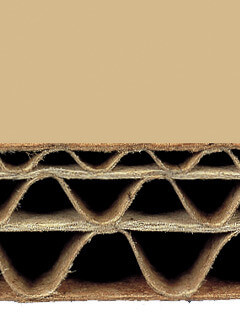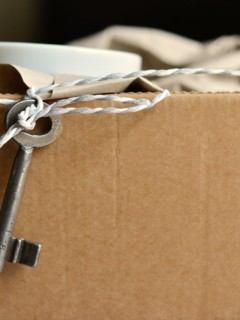Adhesive tapes
Nowadays, adhesive tape has become an indispensable tool in warehouses, logistics, offices and even in homes. There are many different types of adhesive tapes, each serving a different purpose: sealing tapes, insulating tapes, warning tapes, double-sided tapes and many more. Today, we’ll take a closer look at adhesive tapes together. What are the uses of adhesive tapes? What are adhesive tapes made of? What are the most common types of adhesive tapes?
Adhesive tapes
The construction of all adhesive tapes is very similar at the core. An adhesive tape consists of a certain substrate that creates the characteristic properties of the tape, such a substrate can be for example plastic, fabric or paper. Another integral part of the adhesive tapes is the adhesive, which completes their characteristic properties and must, above all, maintain a permanent adhesion. The most commonly used types of adhesives are rubber and acrylic.
An important feature and one of the reasons why adhesive tapes are so popular is their ease of use – there is no need to heat or soak them, just press them onto the surface.
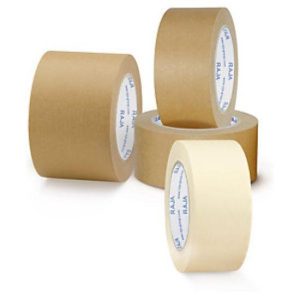
Division of adhesive tapes
Adhesive tapes can be classified in a number of ways, for example according to their intended use or the material they are made from.
How are adhesive tapes classified according to their use?
Tapes can be classified according to their purpose as follows:
The properties of the tapes depend on the application. For example, paper painter’s tape is an environmentally friendly product, can be easily torn by hand, can be used to cover floors or window sills, is easy to remove and the adhesive leaves no residue on the surface.
Packing tapes are particularly useful in transport – for sealing, securing, sealing and packing various shipments. These tapes are characterised by their high durability, come in different widths and can be made of different materials (PVC, PP, paper). Often there is also the possibility of printing and personalisation of packaging tapes.
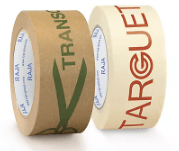
Insulating tapes are ideal for insulating wiring and electrical conductors as they have excellent insulating properties. Mounting tapes are very strong and adhere firmly to all types of surfaces and are also very durable. These tapes are very versatile and can be used for a variety of purposes such as sealing doors and windows, for various repairs, fixing etc.
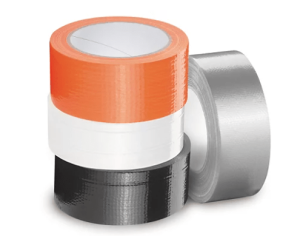
Double sided tap es are a versatile tool in the home, office and warehouse. They can be used in a variety of ways to adhere different types of materials such as posters, floor coverings, carpets and many more.
What materials are used to make adhesive tapes? How can we divide adhesive tapes by material?
Tapes can also be divided, for example, according to the material of the substrate (backing material) or the type of adhesive used.
The backing material has the task of carrying the adhesive and the binder. The tear strength and stretchability of the adhesive tape also depend on this.
The most commonly used types of adhesive tape carrier material are:
In addition to these most commonly used materials, there are other backing materials such as cotton, non-wovens and viscose for textile tapes and metal (e.g. aluminium adhesive tape) for adhesive tapes, which are mainly used in industrial, commercial and construction applications.
|
PP |
PVC |
Paper |
|
Benefits |
||
| tear resistance | High tear resistance | environmentally friendly |
| high instant adhesion | high durability | up to 100% recyclability |
| cost-effective | quiet unwinding | quiet and easy unwinding |
| easy unwinding | Moisture and temperature resistant | can be unwound by hand |
| available with hot-melt, acrylic or natural rubber adhesive | can be easily printed | very good immediate and permanent adhesion |
|
Disadvantages |
||
| does not have good long-term adhesion | not environmentally friendly | low flexibility |
| loud unwinding (but silent PP tape is also available for noiseless unwinding) | more expensive than PP and paper tapes | opacity |
|
Application |
||
| for light to medium weight boxes that are not stored | for medium to heavy cartons, also suitable for storage | light to medium weight cartons, reinforced up to heavy boxes |
Adhesive tapes can also be differentiated according to the type of adhesive, the following 3 are most commonly used:
- Hot-melt (Synthetic rubber) – synthetic adhesive, adheres to many surfaces
- Acrylic adhesive – synthetic adhesive, permanent adhesion
- Natural rubber – strong and durable, leaves no residue, eco-friendly adhesive option
|
Hot-melt |
Acrylic adhesive |
Natural rubber |
|
Advantages |
||
| High initial adhesion (adheres quickly and sticks immediately) | Continuous adhesion and good tack (particularly suitable for long-distance transport) | High bonding strength, fast adhesion |
| cost-effective | high transparency | environmentally friendly |
| good sealing properties under normal conditions | Suitable for longer storage and outdoor use due to high UV and ageing resistance (max. 1 year) | wide range of applications thanks to many variants of strong and weak adhesives |
| easy unwinding | easy unwinding | good temperature resistance |
|
Disadvantages |
||
| low UV and ageing resistance (max. half a year) | limited recyclability of cartons | low UV and ageing resistance (max. half a year) |
| loud unwinding | temperature sensitivity | yellowing on prolonged storage |
| temperature sensitivity | weaker initial adhesion | possible colour differences due to natural product |
When selecting adhesive tapes, it is important to consider the purpose for which the tape will be used in order to choose a tape that is strong and durable enough, or on the contrary, easy to peel and tear by hand. It’s also a good idea to consider the material of the tapes, if the purpose allows it, we can often reach for greener alternatives.











